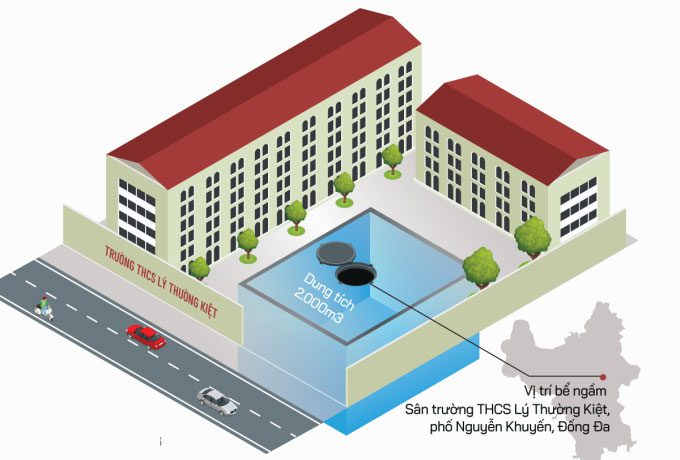A 2,000 m3 underground reservoir has been constructed at Lý Thường Kiệt Secondary School to address the flooding issues on Nguyễn Khuyến Street (Đống Đa District, Hanoi).
For decades, Nguyễn Khuyến Street has been one of the major flooding hotspots in Hanoi. According to the Hanoi Drainage Company, whenever rainfall reaches 30-70 mm per hour, the stretch of road in front of Lý Thường Kiệt Secondary School becomes submerged by 30-70 cm, extending for hundreds of meters. This situation disrupts traffic and poses safety risks for students at both Lý Thường Kiệt Primary School and Secondary School. There have been incidents in this area where electrocution occurred due to flooding, resulting in fatalities.
The severe flooding is attributed to the low elevation of Nguyễn Khuyến Street, which is 50-80 cm lower than the surrounding infrastructure. The street is also located far from the drainage outlets, and the drainage system is not well-integrated.

Location of the constructed underground reservoir on Nguyễn Khuyến Street. (Graphic: Tiến Thành)
In 2019, Đống Đa District launched a project to upgrade the drainage system on Nguyễn Khuyến Street in conjunction with the renovation of Nguyễn Khuyến, Văn Miếu, and Quốc Tử Giám streets, with a total investment of over 24 billion VND. The construction of the underground reservoir is one of the project components.
The underground reservoir was built in mid-2020 and was handed over to the Hanoi Drainage Company for operation at the end of 2021. Located in the courtyard of Lý Thường Kiệt Secondary School, the reservoir is constructed of reinforced concrete, measuring 34 m long, 9 m wide, and 6.6 m deep, with a capacity of 2,000 m3. The thickness of the base and walls of the reservoir is 50 cm, and the ceiling is 30 cm thick. A reinforced concrete column is positioned in the middle of the reservoir to support the ceiling.
During heavy rainfall, the water collection system in front of Lý Thường Kiệt Secondary School directs water into the reservoir through a pipe that is over 22 m long. The reservoir is equipped with three submersible pumps (two operational and one backup). Once the rain subsides and the water level in the city drainage system decreases, the two pumps will transfer water from the reservoir back into the system.
 Flooding point on Nguyễn Khuyến Street in July 2019, before the underground reservoir was built.
Flooding point on Nguyễn Khuyến Street in July 2019, before the underground reservoir was built.
Flooding point on Nguyễn Khuyến Street in July 2019, before the underground reservoir was built. (Photo: Giang Huy)
The construction of the underground rainwater reservoir was proposed by Hanoi in 2018. The Hanoi Drainage Company suggested creating underground reservoirs to manage rainwater at three chronic flooding points: Đường Thành Street, the intersection of Phan Bội Châu and Lý Thường Kiệt (Hoàn Kiếm), and Nguyễn Khuyến Street. However, to date, only the reservoir on Nguyễn Khuyến Street has been built.
According to a representative from the Hanoi Drainage Company, previously, during a rainfall of 138 mm in 2 hours, such as on the afternoon of May 29, the flooding on Nguyễn Khuyến Street would last for half a day. Since the underground reservoir began operations, the flooding duration has significantly decreased to just 1-2 hours. To completely resolve the flooding issue at this location, the Drainage Company stated that the renovation project for Linh Quang Lake must be expedited. Currently, the rainwater cannot drain into the lake due to the incomplete renovations.
The heavy rainfall on the afternoon of May 29, which broke historical records, caused hundreds of flooding points across Hanoi. Speaking to the press in the National Assembly corridor on May 30, Minister of Natural Resources and Environment Trần Hồng Hà suggested that, in the short term, the city could use pumping systems to drain water, but in the long term, it is necessary to explore technical solutions, such as constructing large underground reservoirs in frequently flooded areas. The city could also utilize large open spaces like fields and stadiums as water retention areas.
Globally, many countries have built underground water storage systems. For example, Japan has large reservoirs that serve both to hold water during rainfall and provide water during droughts. “These solutions are costly, so the most important thing is to have a vision and develop integrated urban infrastructure,” Minister Hà emphasized.



















































